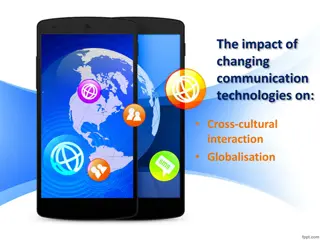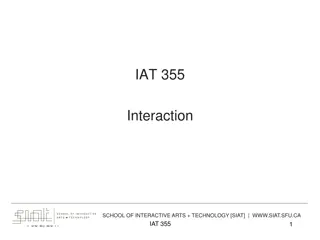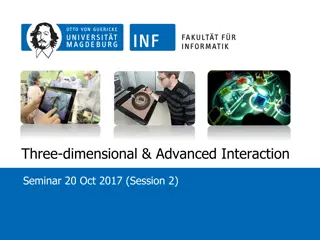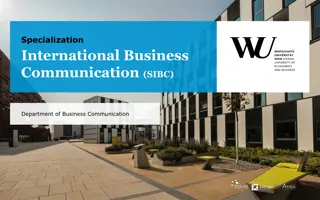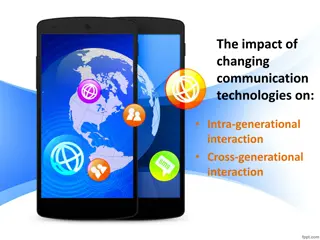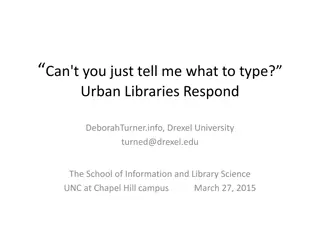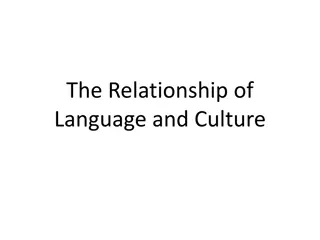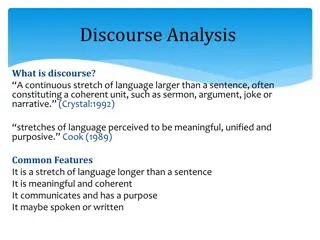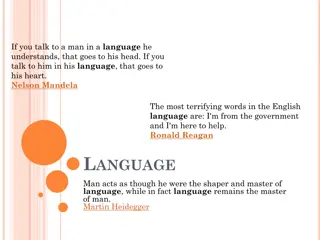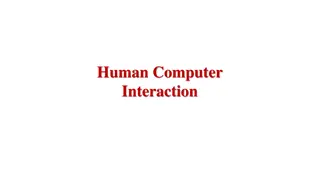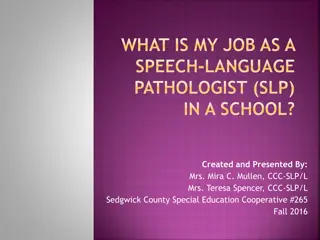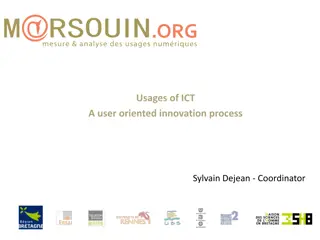The Impact of Changing Communication Technologies on Language Usage and Social Interaction
Technology has revolutionized the way communication is conducted, altering language usage and social interactions significantly. From the evolution of written communication to the emergence of emojis and new grammar structures in texts, the impact of technology on language is profound. Social media platforms have transformed the dynamics of social interaction, breaking geographic boundaries and introducing new ways of connecting. This shift raises questions about the effectiveness of these modern communication methods and the nuances of conveying meaning without traditional body language cues. Cultural transmission and acculturation also play a vital role in shaping language evolution in this digital age.
Download Presentation

Please find below an Image/Link to download the presentation.
The content on the website is provided AS IS for your information and personal use only. It may not be sold, licensed, or shared on other websites without obtaining consent from the author. Download presentation by click this link. If you encounter any issues during the download, it is possible that the publisher has removed the file from their server.
E N D
Presentation Transcript
The impact of changing communication technologies on: Language usage Social Interaction
Language Usage Technology has changed the way in which written communication is used. Many emails now read as though they are being spoken and the letters have become less formal. SMS has taken on a new language entirely; the grammar and conventions tend to be different depending on the age of the user. In some situations, there is a complete lack of language: why bother typing and reading when a photo or an emoji will say it all? Professional tennis player, Andy Murray tweeted his wedding day using only emojis
Activities 1. Read the article How social media is changing language (link and questions on next slide) and complete the questions. 2 . Click on the image (left) to access McCrindle Research on the language of Gen Z (Hyperlink also provided in the notes section of this PPT) ttp://s3-ie.news.eyeka.net.s3.amazonaws.com/wp-content/uploads/2014/05/Hashtag.png 3 . Click on the # to watch the #hashtag YouTube clip (Hyperlink also provided in the notes section of this PPT) N.B LANGUAGE WARNING IN LAST 3 SECONDS OF CLIP
Technology has brought about considerable change in the way people, particularly younger people, communicate. Even email has been surpassed by texting and using social networking websites as the preferred methods of keeping in touch . This raises issues about the effectiveness of these types of communication. People may find it easier to communicate about delicate subjects when texting, but there is of course no body language to observe and interpret which may add meaning to the messages being conveyed. It could be argued that the skills required to condense thoughts into a short text message make its meaning succinct and clear. Texting and social networking websites also introduce another dimension to intercultural communication. First, these methods introduce the idea of commonality in ways of communicating and could potentially lead to an increase in the amount of cross-cultural communication, but equally the potential remains for misunderstanding of words, codes and symbols according to varying cultural contexts. How social media is changing language article http://blog.oxforddictionar ies.com/2014/06/social- media-changing- language/
ARTICLE QUESTIONS 1. In what ways has technology changed the language? 2. Why do you think new methods of communication language? 3. How have new meanings impacted on how we communicate? 4. What do you think drives the creation of new words and how does it gain acceptance and usage? 5. What role do you think cultural transmission and acculturation play in this process? way we use have altered words and wider social
Social Interaction The technology people to be spontaneous in their social Geographic boundaries are no longer relevant to many of our social interactions. However, technology is also impacting the way we socially interact and has created the online disinhibition effect which examines differences between online and offline social interaction instant nature encourages of interactions. the
Activities Have you ever left your phone behind? Watch ttps://www.whitecardonline.com.au/wp-content/uploads/2016/02/mobile.jpeg Read the Social Media and Interpersonal Communication article (link on next slide) and complete the questions.
Social Media and Interpersonal Communication article http://www.socialworktoday.com/archiv e/051313p10.shtml
The Online Disinhibition Effect Thompson, K. et al (2015). Society & Culture, NelsonCengage Learning. South Melbourne (p98- 99) According to psychologist John Suler; the increased use of technology has changed the ways we interact with each other. The online disinhibition effect is an interesting way to understand the online/offline persona. The online disinhibition effect can be seen as a variety of personality traits that vary from the offline personality. Different communication (such as email, text messaging and chat) and different environments bring out a diverse range of personas. For example, it is easier to cancel a dinner arrangement via text or email than by picking up the phone to discuss it. You avoid a range of emotions (primarily, guilt) by emailing or texting. modes of
Questions: Social Media and interpersonal communication 1. How is social media shaping the way we interact with others on a social level? 2. Do you think our reliance on social media is having a positive or negative impact on our personal relationships? Why? 3. Why do you think people feel less personally connected to people when communicating online as opposed to offline? 4. When we communicate through social media, we tend to trust the people on the other end of the communication, so our messages tend to be more open . Why do you think this is? 5. Define the online disinhibition effect. 6. What impact could the online disinhibition effect have in social interactions online?


